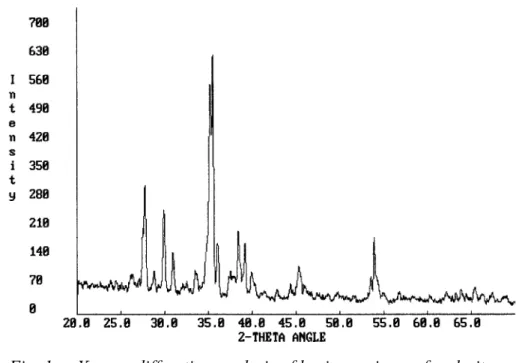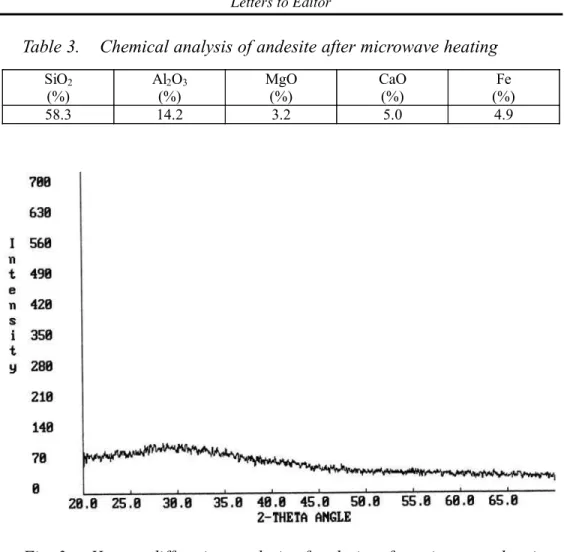Letters to Editor
MELTING OF ANDESITE IN A
MICROWAVE OVEN
I. Znamenácková*, M. Lovás*, M. Hájek**, Š. Jakabský*
*Institute of Geotechnics, Slovak Academy of Sciences, Košice, Slovak Republic,
(e-mail: murova@saske.sk)
**Institute of Chemical Process Fundametals, Academy of Sciences of the Czech Republic,
Prague, Czech Republic
(Received 8 July 2003, accepted 11 September 2003)
Abstract
The positive influence of the microwave radiation on the melting of rocks is described. Local melting-down of specimens and subsequent flowing-out of red-hot magmatic mass was observed when andesite samples from the location of Ruskov (Slovakia) were heated in a microwave own with an output of 900 W. After 30 min of microwave heating of an andesite specimen of defined dimensions, its complete melting was observed and the temperature measured reached the range of 1260-1280 oC.
Keywords:microwave energy, melting, andesite
1. Introduction
the countries use microwaves of frequency of 2.45 GHz with a corresponding wavelength of 12.2 cm. At the present time, microwave energy is used to innovate and intensify technological processes in various branches of industry, e.g. in drying wood, fabrics, paper, in production and processing of glass, ceramic and plastic materials, vulcanisation of rubber and similar. In the field of processing of mineral raw materials, the microwave heating was tested in the processes of drying and desulphurisation of coal [2, 3], chemical treatment of minerals and ores [4], modification of magnetic properties of ores [5] etc. In order to intensify the processes of disintegration of mineral raw materials, attention was paid to the influence of microwave heating on deformation of rocks. The measurement of the rate of propagation of ultrasonic waves in rocks is used to determine the degree of their deformation [6, 7]. Microwave pre-treatment of andesite cylinders resulted in a 40 % decrease in the degree of their deformation after 5 min of heating that was manifested by an increased efficiency of their milling [8].
Prolongation of the heating time or increase in the output of the microwave source can lead in suitable materials to an increase in their temperature always up to the melting point. The present study focused on the processes of melting of andesite in a microwave oven.
1. 2. Basic concept of microwave heating
Energy is transfered to materials by interaction of the electromagnetic fields at the molecular level, and the dielectric properties ultimately determine the effect of microwave field on material. Thus, physics of the microwave -materials interaction is of primary importance in microwave processing. The interaction of microwave with molecular dipoles, and energy is dissipated as heat from internal resistance to the rotation. Microwave heating of material depends on a great extent on its dissipation factor, which is the ratio of dielectric loss or loss factor to dielectric constant of the material.
heated by microwave energy. In fact, ionic conduction and dipolar rotation are the two important mechanism of microwave energy loss.
Mathematically both of these losses may be included in an effective dielectric loss factor:
(1)
where ε′′ is dielectric loss factor, representation of dipolar losses, σ is electric conductivity of material [S.m-1], ω is angular velocity [rad.s-1] and εoispermittivity of free space [F.m-1].
The power absorbed per unit volume can now be written as follows:
(2)
where PABSis power absorbed per unit volume [W.m-3], f is frequency of
the field [Hz] and E is intensity of the electric field [V.m-1].
The following equation can be used to describe in a simplified way the conversion of microwave energy to heat:
(3)
where T is temperature [K], t is time [s], r is density [kg.m-3] and c is
specific heat [J.kg-1.K-1].
The real part of complex permittivity of andesite is about 6. The effective dielectric loss factor, ranges from 0,08 - 0,27 [9].
3. Experimental
The influence of microwave energy on the melting process was investigated on andesite specimens originating from the locality of Ruskov (Slovak Republic). Andesite is a magmatic volcanic rock of light-grey to
grey-, . 0
eff ωεε
σ εε εε′′ = ′′+
PABS =2πε ε0f ′′E2
c P dt dT
Results of chemical analysis of andesite are presented in Tab. 1.
Table 1. Chemical analysis of andesite
X-ray diffraction analysis of andesite was performed using an apparatus DRON 2 O. A diffractogram of a basic andesite specimen is shown in Fig. 1. The X-ray diffraction analysis of the basic specimen of andesite showed the presence of SiO2, smaller proportion of Al2O3and CaO and also the presence of plagioclases, pyroxenes and to a lesser degree of hornblende, biotite and magnetite.
The andesite melting tests in a microwave field were carried out on specimens of cylindrical shape with defined dimensions. The parameters of specimens are summarised in Tab. 2. Andesite cylinders were located in a vertical position on a ceramic plate 3 cm above the oven bottom.
Fig. 1. X – ray diffraction analysis of basic specimen of andesite
SiO2
(%)
Al2O3
(%)
MgO (%)
CaO (%)
Description of microwave equipment:
- a microwave oven Panasonic PRO II NE-2740, frequency of electromagnetic radiation 2450 MHz, maximum output 2 700 W,
- a microwave oven Panasonic NN-5251B, frequency of electromagnetic radiation 2450 MHz, maximum output 900 W.
Temperature of the specimens was measured by non-contact infrared thermometers Raynger MX 4 (measurement range: - 30 ÷ 900 oC) and
Thermalert TXC (measurement range: 400 ÷ 900 oC). The scheme of
temperature measurement during the andesite melting in a microwave oven is shown in Fig. 2.
4. Results and discussion
The andesite specimen (Tab. 2, specimen 1) was placed to a ceramic crucible located in a refractory insulation cover which transmitted microwave radiation and resisted to high temperatures so as to prevent cooling of specimens and the respective energy losses into the surroundings (Fig. 2). In the first phase of heating, the specimen was irradiated at the output of 1 350 W. After 10 min, the specimen was irradiated at the maximum output of 2 700 W. After 30 min of microwave heating the specimen was completely melted and the temperature measured reached 1 260 to 1 280 oC. The temperature
reached corresponded to temperature of magma in nature. Direct measurements of lava temperature in nature showed fluctuating values ranging from 850 oC to 1 300 oC [11]. After melting, the specimen was
SPECIMEN DIMENSIONS
(mm)
WEIGHT (g)
1. 67,1 x Ø 31,8 145,0
2. 78,3 x Ø 31,8 152,7
3. 87,1 x Ø 31,8 186,0
subjected to X-ray diffraction analysis (Fig. 3) and classical chemical analysis (Fig.3) which allowed us to determine the proportion of individual compounds in a dry silicate melt (Tab. 3).
The X-ray diffractogram of re-melted andesite suggested that practically the entire specimen was in an amorphous state. Chemical analysis of the remelted specimen showed only small differences in the values of the components determined in comparison with the primary andesite specimen.
In order to investigate the process of melting of andesite cylinders, the specimens No. 2 and No. 3 (Tab. 2) were irradiated at the output of 900 W while deposited freely an a ceramic plate without an insulation cover. Melting down of andesite specimens in a microwave oven for 10 and 15 min is documented in Fig. 4. During the microwave heating, the specimens became
4
Fig. 2. Schematic representation of andesite melting in a microwave oven with continuous measurement of temperature
hot approximately in their central parts. Subsequently, smelting of the red-hot magmatic melt occurred. After the selected time of microwave heating of andesite specimens, one could observe formation of an oval cavity inside the rock and flowing-out of black, compact, vitreous material.
5. Conclusion
To validate the possibility of application of microwave heating in innovation of the process of thermal treatment of rocks, experiments with
SiO2 (%)
Al2O3 (%)
MgO (%)
CaO (%)
Fe (%)
58.3 14.2 3.2 5.0 4.9
Table 3. Chemical analysis of andesite after microwave heating
melting of andesite specimens in an microwave oven were conducted. Comparison of the properties of andesite specimens in their natural form and after melting showed that the basic andesite material had originally porphyrite structure formed by fine strips of plagioclases and grains of pyroxenes. After cooling of the melted specimen a black, compact material of vitreous structure developed. The andesite specimen examined was subjected to classical chemical analysis and X-ray diffraction analysis before and after the heating in the microwave oven. The chemical analysis revealed that the basic components of andesite were SiO2, Al2O3and CaO. The analysis of the melted specimen revealed that the proportion of individual components did not change essentially during the melting process. No weight losses were observed after melting. The X-ray analysis of the primary andesite confirmed the results of chemical analysis. It proved that the specimen structure turned amorphous after melting.
Fig. 4. Heating of andesite in microwave oven:
Acknowledgement:
The authors are grateful to the Slovak Grant Agency for Science ( Grant No. 2/2105/22 ) for the financial support of this work and RNDr. E. Boldi`árovej, PhD. for X-ray analysis.
References
1. Z. Horák, F. Krupka, Physics, SNTL Prague, 1996 (in Czech) 2. J. Hayashi et al., Fuel, 69 (1990) 739
3. I. Murová, M. Hájek, M. Lovás, Chemical Papers,4 (2002) 182 (in Slovak)
4. M. Lovás, I. Murová, A. Mockovciaková, N. Rowson, Š. Jakabský,
Separation and Purification Technology, 3 (2003) 291
5. I. Murová, M. Lovás, Š. Jakabský, J. Briancin, E. Boldi`árová, Acta
Montanistica Slovaca, 1 (2002) 19 (in Slovak)
6. A. Mockovciaková, B. Pandula, Metalurgija 1 (2003) 37 7. A. Mockovciaková, B. Pandula, Acta Avionica 2(2000) 73
8. I. Murová, M. Lovás, Š. Jakabský, Optimizacia procesa i povecanje energetske efikasnosti u pripremi mineralnih sirovina, Rudarsko-geoloski fakultet, Univerzitet u Beogradu, Beograd, 2002, p. 27 9. R. J. Adams, W. F. Perger, W. I. Rose, A. Kostinski, J. Geophys. Res.,
101 (1996) 8175
10. P. Rybár, K. Kyselová, M. Cehlár, M. Zacharov,Metalurgija2(2002) 99 11. O. Kumpera, J. Foldyna, V. Zorkovský, General Geology, SNTL



